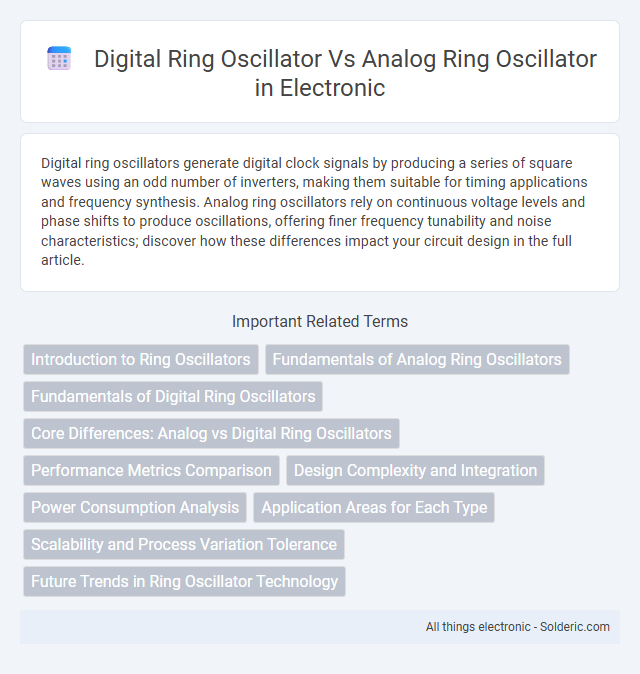Digital ring oscillators generate digital clock signals by producing a series of square waves using an odd number of inverters, making them suitable for timing applications and frequency synthesis. Analog ring oscillators rely on continuous voltage levels and phase shifts to produce oscillations, offering finer frequency tunability and noise characteristics; discover how these differences impact your circuit design in the full article.
Comparison Table
| Feature | Digital Ring Oscillator | Analog Ring Oscillator |
|---|---|---|
| Operation Type | Digital signal transitions | Continuous analog signal oscillation |
| Frequency Control | Determined by supply voltage and inverter delay | Controlled by bias current and transistor parameters |
| Output Signal | Square wave | Sine-like waveform |
| Power Consumption | Generally lower, depends on switching activity | Typically higher due to continuous current flow |
| Noise Sensitivity | Less sensitive, digital logic levels | More sensitive to noise and process variations |
| Temperature Dependence | Frequency varies with temperature and supply voltage | Frequency shifts with device parameters and temperature |
| Application | Delay measurement, clock generation, PVT monitoring | Frequency synthesis, voltage-controlled oscillators (VCOs) |
| Complexity | Simple digital inverter chain | Requires analog biasing and careful design |
Introduction to Ring Oscillators
Ring oscillators generate oscillating signals by connecting an odd number of inverters in a feedback loop, commonly used for testing and timing applications. Digital ring oscillators consist of discrete inverter stages operating with binary signals, offering precise frequency control and ease of integration in digital circuits. Analog ring oscillators employ continuous-time amplifiers and nonlinear elements, providing tunable frequency ranges and superior phase noise characteristics for analog and mixed-signal applications.
Fundamentals of Analog Ring Oscillators
Analog ring oscillators consist of an odd number of inverting amplifiers connected in a feedback loop, where each stage introduces a precise analog delay determined by the device's transistor characteristics and bias currents. These oscillators rely on continuous-time analog signals, making the oscillation frequency highly sensitive to variations in voltage, temperature, and process parameters. The fundamental operation is governed by device-level nonlinearities and delay stages, enabling fine frequency tuning through bias current adjustments and device sizing.
Fundamentals of Digital Ring Oscillators
Digital ring oscillators consist of an odd number of inverters connected in a loop, creating a propagation delay that produces a stable oscillation frequency determined by the number of stages and inverter delay. These oscillators rely on digital switching behavior, generating square wave outputs ideal for timing applications in integrated circuits. Your design choices impact frequency stability and power consumption in digital ring oscillators compared to analog counterparts that produce continuous waveforms.
Core Differences: Analog vs Digital Ring Oscillators
Digital ring oscillators generate oscillations using a chain of digital inverters with discrete voltage levels, producing a square wave output ideal for digital timing applications. Analog ring oscillators rely on continuous-time amplifiers and feedback paths, creating sinusoidal or triangular waveforms with higher frequency stability and lower phase noise. The core difference lies in signal representation--digital oscillators utilize binary states while analog oscillators operate with continuous voltage variations, impacting their respective noise performance and integration complexity.
Performance Metrics Comparison
Digital ring oscillators offer higher frequency stability and lower phase noise compared to analog ring oscillators, making them suitable for precision timing applications. Analog ring oscillators exhibit better tunability and lower power consumption, which is advantageous in low-power systems and frequency synthesis. The choice between digital and analog ring oscillators depends on the specific requirements for jitter performance, power efficiency, and frequency control in the target application.
Design Complexity and Integration
Digital ring oscillators feature simpler design complexity with straightforward digital components, enabling easier integration into large-scale digital systems and standard CMOS processes. Analog ring oscillators require more intricate transistor-level design and precise analog tuning, making their integration more challenging, especially in mixed-signal environments. Your choice depends on the trade-off between design simplicity and the need for fine frequency control in your application.
Power Consumption Analysis
Digital ring oscillators typically consume less power due to their discrete switching behavior and efficient CMOS technology implementation, making them ideal for low-power applications. Analog ring oscillators, while offering finer frequency control and lower phase noise, often exhibit higher static current consumption as a result of continuous biasing and analog components. Evaluating your design's power budget requires balancing these trade-offs to select the optimal oscillator type for your specific application.
Application Areas for Each Type
Digital ring oscillators are widely used in integrated circuits for clock generation, frequency synthesis, and performance monitoring due to their ease of integration and precise digital control. Analog ring oscillators find applications in communication systems, sensor interfaces, and low-power analog signal processing where phase noise and frequency tunability are critical. The choice between digital and analog ring oscillators depends on system requirements such as signal fidelity, power consumption, and integration complexity.
Scalability and Process Variation Tolerance
Digital ring oscillators exhibit superior scalability due to their reliance on discrete logic gates, allowing easier integration with advanced CMOS technologies and seamless replication for larger arrays. Analog ring oscillators, while capable of finer frequency tuning via biasing, suffer more from process variations that affect transistor matching and component linearity, reducing their tolerance in scaled-down nodes. The inherent digital nature of digital ring oscillators ensures more robust operation across process corners and temperature changes, making them preferred in modern, high-density integrated circuits.
Future Trends in Ring Oscillator Technology
Future trends in ring oscillator technology emphasize increased integration with digital circuits to enhance performance and reduce power consumption. Digital ring oscillators offer superior scalability and programmability, making them ideal for advanced applications like IoT and AI hardware. Your choice between digital and analog designs hinges on balancing precision timing needs with energy efficiency and system complexity.
Digital ring oscillator vs Analog ring oscillator Infographic

 solderic.com
solderic.com